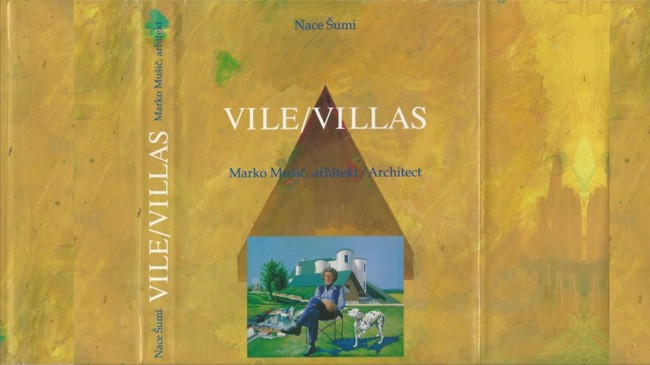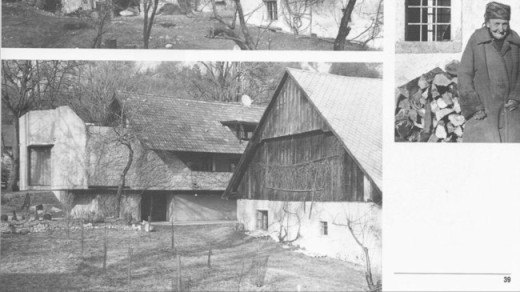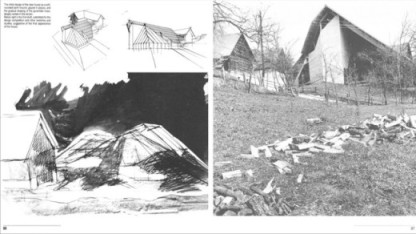



|
Iz knjige ...Arhitektura Marka Mušiča ima nekatere lastnosti, ki so nujne in značilne za dobro arhitekturo, za stanovanjsko še prav posebno. Če kdo, je danes Marko Mušič zelo odličen predstavnik tiste smeri, ki sem jo označil kot organsko: vključuje posebno razmerje do okolja, ga nikoli ne posiljuje, marveč se mu, nasprotno, vselej obzirno prilagaja. Tipično vprašanje, ki si ga naš arhitekt vselej postavlja, se glasi: Ali stavba moti? Organsko v arhitekturi ni nujno povezano zgolj z vegetabilnim načelom, ki se je uveljavilo posebno v secesijski dobi. Prej mislim s to oznako na kompozicije, v katerih se združijo različne sestavine v vertikalnih in horizontalnih smereh v večje, logično utemeljene, toda tudi z gibljivimi sestavinami oblikovne sklope. V takem smislu so različni avtorji označevali na primer delo F. L. Wrighta ter vrste drugih oblikovalcev. Z varovanjem okolja pa je Marko Mušič prav obseden. Obseden do tolikšne mere, da ga označujem za neke vrste panteista, ki mu je vse v okolju dragoceno in spoštovanja vredno. Potemtakem je pomembna prvina organskega prav odnos do okolja, odnos, ki stori, da občutimo arhitekturo kot neločljivi del celotnega ambienta naravnega in (ali) kulturnega okolja. Zelo se čudim, da nekateri ocenjujejo Mušičevo delo kot tako samozavestno, da so pripravljeni govoriti celo o posiljevanju okolja. Tukaj je jasno videti, da zamenjujejo ustvarjalno moč z odnosom do okolja. Vselej je mogoče zaznamovati ravno nasprotno razmerje. Ta arhitektura se vključuje v okolje, iz njega raste in se vanj poglablja. Po teh lastnostih je snovanje Marka Mušiča med nami prav izjemno. Organska arhitektura vključuje tudi upoštevanje ne le običajnih nadzemeljskih ravnin, marveč pogosto tudi podzemlje. Arhitekt sam se po moji vednosti ni izrecno, načelno opredelil do tega vprašanja, do posebne ljubezni in skorajda nuje, da vključuje podzemske prostore v svoje projekte in realizacije. Zato se ni mogoče upreti razlagi, da gre za najgloblje, kar instinktivno zasidrane vezi do te ravnine. Da je res tako, govori tudi monumentalna cerkev v Dravljah, kjer je iz podzemeljske plasti mogoče spremljati celotno zunanje okolje od stare cerkve pa tja do pokopališča. Takšna rešitev govori o vsebinski razsežnosti vključevanja podzemlja v arhitekturo... From the book …The architecture of Marko Mušič has certain properties that are necessary and typical for good architecture, especially for housing architecture. If anyone, Marko Mušič is a very excellent representative of the direction that I have described as organic: it includes a special relationship with the environment, he never imposes on it, on the contrary, always gently adjusts to it. A typical question always put by our architect, is as follows: Is the building imposing on you? Organic in architecture is not necessarily associated only with the principle of vegetation, which has been established especially in the Art Nouveau era. I mean by this naming the compositions in which various components are combined in vertical and horizontal directions in the larger logical, but also with moving components designed assemblies. The work of F. L. Wright as well as a range of other designers were described in this manner. Marko Mušič is obsessed with protecting the environment. Obsessed to the extent that I denote him as a kind of Pantheist that considers all in the environment valuable and worthy of respect. Therefore, relationship with the environment, a relationship that manifests the feeling of architecture as an inseparable part of the overall ambience of the natural and (or) cultural environment is also an important component of the organic. I wonder that some estimate Mušič’s work as so confident that they are even willing to talk about the rape of the environment. There is clear that they replace the creativity with relationship to the environment. It is always possible to mark the opposite relationship. This architecture is included in the environment; it grows from it and deepens into it. According to these properties the design by Marko Mušič is outstanding. Organic architecture also includes consideration of not only surface planes, but often the underground. The architect himself of my knowledge is not explicitly defined in principle to this issue, the special love and almost of necessity to include underground spaces in their projects and realization. It is not possible to resist the interpretation that this is the deepest, which instinctively anchored links to this plane. That this is so speaks the monumental church in Dravlje, where from the underground strata one can monitor the external environment of the old church and up to the cemetery. Such a solution is about substantive dimension of integration of the underworld in the architecture... CIP - Kataložni zapis o publikaciji Narodna in univerzitetna knjižnica, Ljubljana MUŠIČ, Marko Vile = Villas / Marko Mušič ; [besedilo, text] Nace Šumi ; [zasnova gradiva, izbor in priprava gradiva, conceived, selected and prepared by Sonja Kolar ; prevod, translation Agencija A3, Ljubljana ; fotografije, photographs Dragan Arrigler ; fotografije Dragan Arrigler ... et.al.]- Ljubljana: Znanstveni inštitut filozofske fakultete, 2001 ISBN 86-7207-135-2 |